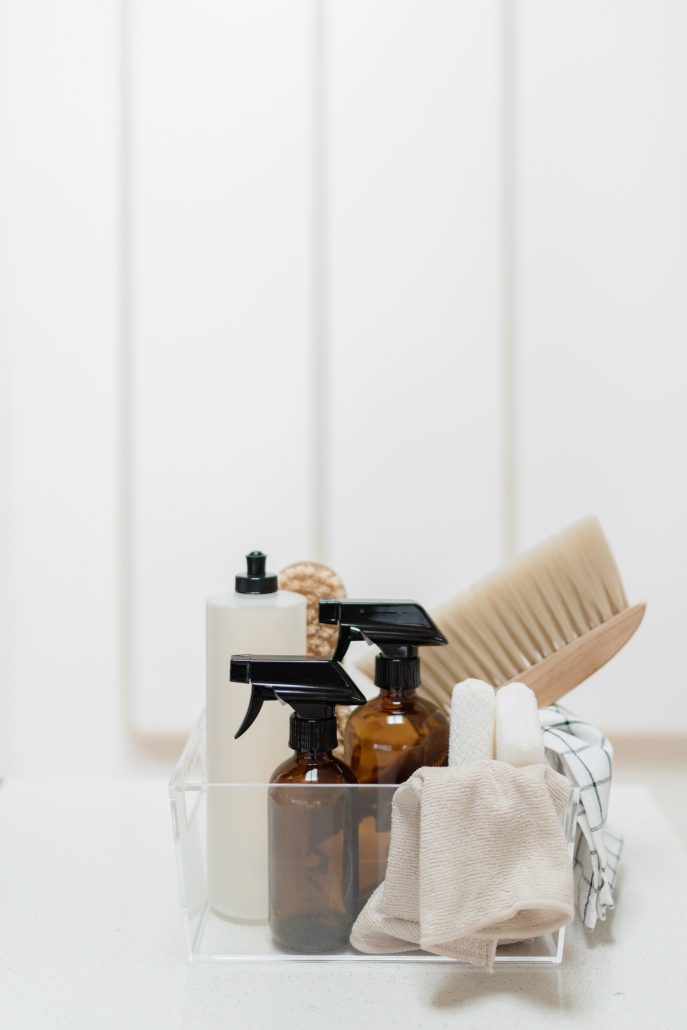
Clean living has a lot to do with the foods we eat each day, but it also encompasses everything from the products we apply to our skin, hair, and nails, to the cleaning solutions we use to disinfect our living spaces. I’m talking about our cosmetics, shampoos, conditioners, facial cleaners, toothpastes, bathroom disinfectants, hand soaps, laundry detergents, and ALL the other products we use in our daily lives (think: toilet paper, facial tissues, paper towels, feminine care products, dish soap, toilet bowl cleaners, candles, and so on).
But why should we choose non-toxic personal care products when we’re already eating a clean diet? Does it really matter which products we use if we aren’t eating them? The answer is YES, it absolutely matters!
Everything we do — from the food we eat to the products we use — either supports or harms our health. The choices we make each day add to our toxic load or help to reduce it. Let me explain.
Toxins Are Everywhere
The average adult comes into contact with 126 unique chemical ingredients each day from the personal care products they use to cleanse, wash, moisturize, and enhance the way they look and feel. And the average woman is exposed to even more — around 168 unique chemical ingredients each day — as women tend to use more personal care products than men. For instance, just one bottle of traditional nail polish (versus less-toxic nail polish) contains harmful chemicals like phthalates, toluene, and formaldehyde. Yikes!

Of course, this doesn’t even account for the thousands of toxins we’re exposed to daily from the air we breathe, the food we eat, the water we drink, the dust collecting on our household belongings, and the soil in which our food is grown. Oh, and let’s not forget about the chemicals in our cookware, carpeting, building materials, shower curtains, cleaning products, and furniture. The list goes on!
Are the Things Meant to Help Actually Causing Harm?
Here’s the thing: the foods, beverages, air, soil, and products that are meant to keep us nourished, hydrated, healthy, and living are loaded with potential toxins and carcinogens (carcinogens are cancer-causing substances). These toxins have short- and long-term health effects like hormone dysfunction, infertility, birth defects, diabetes, heart disease, obesity, and even cancer.
Phthalates, for example, are chemicals that disrupt the endocrine system by mimicking or suppressing our hormones. Phthalate exposure is harmful to our developmental, reproductive, and neurological health — and what’s most scary here is that these chemicals are commonly found in everyday products like nail polishes, toothbrushes, cosmetics, and various household furnishings. Phthalates are also used to make plastics and solvents.

Children & Phthalates
Children are especially susceptible to the detriments of phthalate exposure. A study published in the journal Healthcare linked childhood phthalate exposure to obesity, thyroid dysfunction, early puberty, asthma, high systolic blood pressure, insulin resistance, and type 2 diabetes in children.
Children and infants are typically exposed in the following ways:
- Ingesting foods containing phthalates (certain meats, dairy products, and fats are significant sources)
- Drinking breast milk or infant formulas containing phthalates
- Sucking on toys and other objects made with phthalates
- Inhaling or ingesting contaminated air and water
- Using personal care products containing phthalates (look for baby-safe products online here)
Furthermore, infants and their mothers are exposed to phthalates through contact with flexible medical bags and IV tubing. They may come into contact with phthalates while receiving IV therapy, transfusions, or when using medical devices made of polyvinyl chloride (PVC).
Where to Go From Here
So while the foods and products we use in our everyday lives are meant to benefit us in one way or another, at what expense are we willing to use products that contain endocrine-disrupting chemicals like parabens, phthalates, sodium lauryl sulfate (SLS), and synthetic colors and fragrances? Or carcinogens like formaldehyde, hydroquinone, and benzene?
Countless toxic substances in our personal care products (like microbeads and microplastics) are also super damaging to the environment. And while there’s no way to avoid many of these toxic substances altogether, adopting a clean living lifestyle dramatically reduces our exposure and, in turn, reduces our toxic load!
How to Find Non-Toxic Products for Cleaner Living
There’s no doubt the products we use on the daily are putting our health (and the health of our children) at risk. The best thing we can do here is choose non-toxic or less-toxic alternatives to traditional cosmetics, personal care products, household cleaners, furniture, foods, and other household furnishings.
A few seemingly minor changes can make a big difference!
Beautycounter is my personal go-to for most cosmetics and skincare products, mainly because they prohibit the use of more than 2,800 ingredients like phthalates, parabens, SLS, and formaldehyde. Some other great options for clean, non-toxic personal care products include:
- Prose
- Farmtrue
- RiseWell
- Cocokind
Along with using cleaner products from these brands, the Environmental Working Group (EWG) is a fabulous resource for choosing low-tox products for your home and body. The EWG has Consumer Guides to find non-toxic household cleaners; produce; drinking water; and cosmetics, sunscreens, hair products, fragrances, and other personal care products.
The EWG’s Healthy Living App is also super helpful while on the go! Just open the app and scan the product you’re considering to find out whether it contains any potentially harmful ingredients before buying.

Try 21 Days of Clean Living
If you’re curious about clean, non-toxic living, my signature Nourish 21 program is the perfect opportunity to clean up your diet, home, and lifestyle in just three weeks! During these 21 days together, I’ll teach you how to nourish your body and mind with clean, inflammation-fighting foods, and choose low-tox products for your skin, hair, nails, and home. Nourish 21 is your first step toward cleaner living!